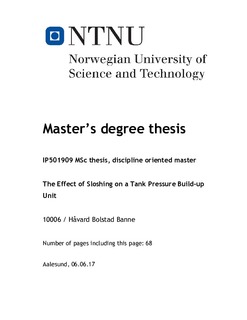| dc.description.abstract | This thesis work has aimed to identify how sloshing will affect a liquefied natural gas (LNG) fuel
tank. The physical nature of LNG means it needs to be kept cooled and pressurized in order to
remain in a liquid state. By implementing a pressure build-up unit (PBU) it is possible to pressurize
the tank vaporizing the tank’s contents, for the vapour then to return to tank in a loop,
building pressure in the process. A tank pressure build-up unit has been built in the laboratory
at the university, which will be used for conducting experiments on sloshing.
To be able to perform calculations on the system, the efficiency of the electrical heater is found
through a simple experiment, measuring the mass of water the heater is able to vaporize per
minute, as well asmeasuring the electrical power used. Four different power settings are tested,
showing that the relation between flow and power are close to linear, meaning that it is possible
to interpolate the vaporized flow should one want to use a different power setting than the
ones already tested. The electrical power tested ranges between 570-2019W, with the efficiency
ranging from 83.8-95.2%. The difference in efficiency is likely due to the water level rising when
subject to higher levels of power, thus utilizing more of the heating coil, which is not fully submerged
initially.
The heat loss of the system, or more specifically the heat transfer coefficient between the interior
of the tank and its environment is found through logging of the system’s temperature as the
tank cools down, having initially been heated up to temperature of more than 110°C. Once the
liquid and vapour temperature are equal, one can assume that no heat transfer is happening
inside the tank, thus the following drop in temperature is due to heat loss to the surroundings.
By recording the drop in temperature over a given time, the heat transfer coefficient is then calculated
to beU Æ 0.31W/m2K.
To find howsloshing affects this specific system, several tests are performed at different frequencies
in order to observe how the severity of the sloshing affects the thermodynamical properties
within the tank. The tank is heated to predetermined parameters, before the heater is turned off
for the sloshing to be initiated, this in order to be in control over the amount of energy present
in the systemwhen the sloshing is performed. It is found that sloshing definitely increases heat
and mass transfer over the liquid-vapour interface when compared to test conducted where no
iv
tank motion is initiated. There is a clear distinction in heat and mass transfer between the different
sloshing frequencies as well, where the general perception is that a higher frequency of
sloshing results in a higher rate of energy transfer.
It is attempted to conduct a series of experiments where the heater is on during the tests, in
order to see if compensation of the pressure drop during sloshing was possible. It is found that
utilizing the heater does result in reduced drop in pressure, in addition to showing that pressure
compensation is possible in lower frequencies with the electrical power at disposal for these experiments,
albeit not entirely stable. With control regulation, compensation should work well.
The effect sloshing would have on heat and mass transfer was calculated from results gathered
from the experiments. Calculating for a selection of tests with sloshing period ranging from
T=2.50 seconds to T=4.00 seconds, as well as for a reference test with no tank excitation, it is
found that sloshing at the lowest frequency tested, T=4.00 seconds, increases heat and mass
transfer by 75% compared to the case with no tank excitation. The rate of heat and mass transfer
increases as the sloshing frequency increases, calculations showing a 500%increase for sloshing
period T=2.50 seconds. | nb_NO |

